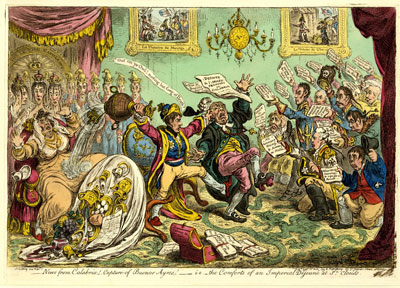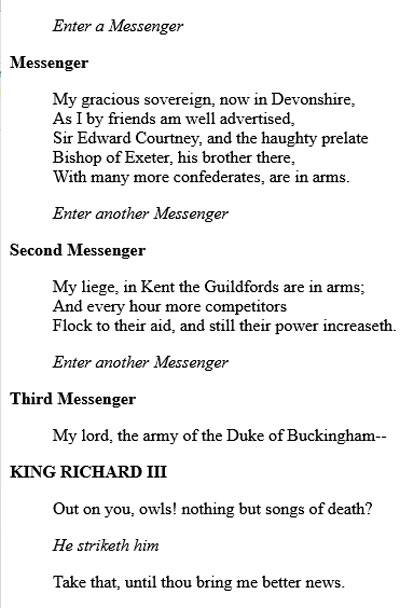News from Calabria! Capture of Buenos Ayres!
The impetus for this print was the news of a rare pair of British victories against the French ground forces in June at Buenos Aires, Argentina and in July at Maida in the Calabrian region of Italy. At the center of the print, an angry Emperor Napoleon Buonaparte grabs the ear of his foreign secretary, Talleyrand, and prepares to strike him with a globe-shaped urn for interrupting his imperial luncheon with the bad news written all over the papers flying out of Talleyrand's upraised hand: Defaite de l'Armée Francois en Calabria" (The defeat of the French army in Calabria), and "la Prise de Buenos-Ayres (the capture of Buenos Aires).

© Trustees of the British Museum
Talleyrand can be identified by his cross and clerical neckcloth (he had been the Bishop of Autun at the start of the Revolution) and the club foot that required him to wear a special shoe. Napoleon appears in a version of the now-familiar guise of the hyperactive Buonaparte that Gillray had begun using in 1803 in prints like German Nonchalence, or the Vexation of Little Boney, and Maniac Raving's, or Little Boney in a Strong Fit to demean and diminish the French leader.
As the subtitle suggests, the scene is set at Chateau de St. Cloud, Buonaparte's preferred residence, where paintings of his most significant military victories are shown to adorn the walls. And virtually every object in the room—from the elaborate wall sconce to the backs of the chairs, to the gilded plates, cups, and pitchers on the luncheon table— trumpets Napoleon's status as Emperor.
But as Napoleon's rage, the overturned table, and the crown falling off the urn are all designed to indicate, things in Buonaparte's world are no longer under his control. His overweening design to "subjugate the world" (headlined in the newspaper, Le Moniteur falling from the table) is in serious jeopardy. Indeed the message from Calabria, as Gillray suggests with more patriotism than accuracy, is just the beginning of a worldwide revolt against French hegemony that bodes ill for the emperor, his wife Josephine, his family, and the foolish kinglets gathered at St Cloud. Twelve more such "songs of Death" occupy the entire right hand portion of the print, using familiar national sterotypes to represent the rebelling countries.
- From Sweden: Swedish Defiance - Charles ye XII Redivivus
- From Germany: All Germany Rising, & Arming en Masse
- From Holland: 'Holland Starving! - & ripe for a Revolt
- From Switzerland: Switzerland cursing the French Yoke
- From Italy: Italy shaking off her Chains
- From Prussia: Prussia rousing from her Trance of Death
- From Russia: St Petersburg - Refusal to Ratify the French Treaty
- From Sicily: Sicily Firing like Aetna
- From Portugal: Portugal True, to the last Gasp
- From Turkey: Turkey Invoking Mahomet
- From Denmark: Denmark waiting for an Opportunity
- From Spain: Spain in Despair for the loss of her Colonies
Even the snakelike dragons in the carpet seem to be threatening Buonaparte and Talleyrand.
As he so often does, Gillray puts into the mouths of his characters words that are appropriate to the moment, but also provide an additional frame to the action we see in the print. In this case, a furious Napoleon berates his foreign secretary with these words:
Out on ye Owl! Noting but song of Death?
With adjustments made for the French-speaking Buonaparte, the words come from Act IV Scene 4 of Shakespeare's Richard III when Richard begins to hear of the gathering opposition to his rule.

© MIT
With the allusion to Shakespeare, Gillray asks us to see Napoleon as another Richard III—brutal, unscrupulous, and power-hungry—and like Richard about to receive his just deserts. But alas, in Napoleon's case, the tragic pendulum did not swing so swiftly. The capture of Buenos Aires, for instance, lasted only 46 days until the British were driven out again by Spaniards allied with France. And the total defeat of Napoleon's armies that Gillray obviously wished for did not occur until after Gillray's death in 1815.
Sources and Reading
- Commentary from the British Museum on News from Calabria! Capture of Buenos Ayres!.
- "Battle of Maida," Wikipedia
- "Battle of Marengo," Wikipedia
- "Battle of Ulm," Wikipedia
- "Napoleon," Wikipedia
- "Charles Maurice de Talleyrand-Périgord," Wikipedia
- "Château de Saint-Cloud," Wikipedia
- "Le Moniteur Universel," Wikipedia
- William Shakespeare, The Life and Death of Richard the Third
- Thomas Wright and R.H. Evans, Historical and Descriptive Account of the Caricatures of James Gillray #324.
- Thomas Wright and Joseph Grego, The Works of James Gillray, the Caricaturist; With the History of His Life and Times, p. 339.
Comments & Corrections
NOTE: Comments and/or corrections are always appreciated. To make that easier, I have included a form below that you can use. I promise never to share any of the info provided without your express permission.